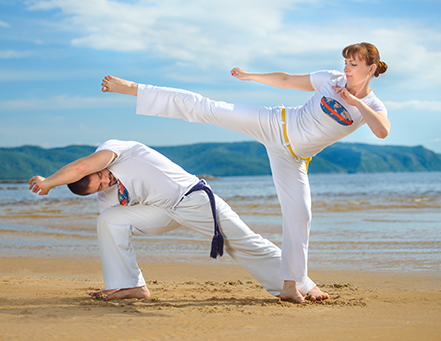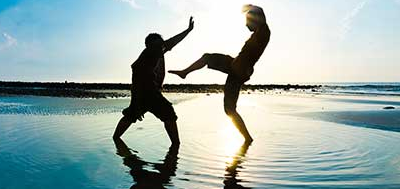
Capoeira is an elegant Brazilian Martial Art which blends features of acrobatics, dance, fighting, movement, rhythm and musical expression. Performed in pairs it is sometimes described as a ‘game’ which is played rather than a fight. Capoeira is practised in a Roda, which means ‘ring’ or ‘circle’ of people with musicians placed at the head of group.
As with many Martial Arts the exact history and origin of Capoeira is dependent on the individual historian’s accounts. What is known is that African Slaves (mainly from Angola), played a huge part in its creation and introduction to Brazil nearly 500 years ago. It is believed that they began to develop self-defence techniques and strategies which looked to disguise combat elements by dancing and singing to music.
The popularity of Capoeira has grown throughout the world and it is now frequently taught in education establishments as part of the curriculum. It has links to a number of popular dance styles meaning it often appears in modern music videos and movies.
Players in the Roda move to the rhythm and beat of the music creating an atmosphere of excitement and exhilaration. Capoeira is a Martial Art which must be ‘lived’ and experienced first-hand in order to be fully appreciated and understood.
At the heart of Capoeira is the ‘Ginga’ which translates to mean ‘swinging back and forth’. This repetitive motion acts as a basis for the rest of the group’s movements. Whilst it may appear like the Roda is dancing it is in fact a continuous fighting stance. The members are prepared the to undertake a variety of combat movements whilst being constantly moving target seeking to confuse their opponent.
Played in a game context the emphasis shifts to performance and entertaining any audience present. High moves, acrobatics, flips and evasive cartwheels all come to prominence.
Capoeira isn’t just a physical workout, it is said a true Capoeirista should learn about the culture and history associated with the art form. There are various fascinating etiquettes and customs to be involved in. One should also consider stretching their practices over to learning traditional musical instruments and songs.

Many schools don’t follow any direct ranking system. In some groups, those who take part in Capoeira are simply a Capoeiristas and there are no belts. It is said a ranking system shifts the focus as Capoeira as a game or art form.
The use coloured ropes called corda is the most common ranking system around for Capoeira. They are based on the colours of the Brazilian flag and cover Aluno (student), Instructor, Professor and Mestre (Master). They are ordered as below:
Aluno – Green Rope
Aluno – Green and Yellow Rope
Aluno – Yellow Rope
Aluno – Yellow and Blue Rope
Instructor – Blue Rope
Professor – Green, Yellow and Blue Rope
Contra-Mestre – Green, Yellow, Blue and White Rope
Mestre 1st Grade – Green and White Rope
Mestre 2nd Grade – Yellow and White Rope
Mestre 3rd Grade – Blue and White Rope
Mestre – White Rope

Anyone can take up Capoeira classes, regardless of age, gender or ability. You are not expected to be able to perform the more physically demanding moves like cartwheels of handstands from the outset. The best way to be prepared to do Capoeira is to do Capoeira! A great all round exercise for both body and mind.
Gymnasts and acrobats however may enjoy the challenge of Capoeira and find they can learn moves more easily. Similarly taking part in other supplementary training will only improve your abilities in Capoeira.
